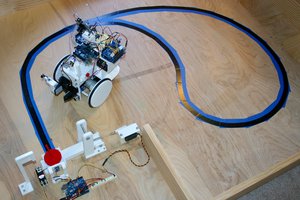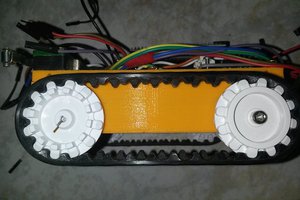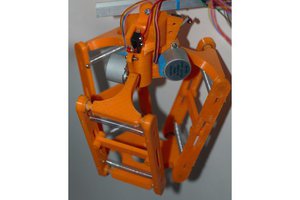A screw-propelled vehicle is a type of land or amphibious vehicle that uses one or more auger-like cylinders fitted with a helical flange to move. The cylinders are rotated by an engine, and the flange engages with the ground or water to propel the vehicle forward. Screw-propelled vehicles are often used in areas with difficult terrain, such as snow, ice, mud, and swamps. They are also used in some military applications.
Supplies

Parts
- 2*N20 motor 3v 50 rpm
- 25mm 5v fan
- TP4056 BMS
- 2*Red LED
- Heat sink for camera
- Heat sink for Xiao
- DRV8833 motor controller
- Slide ON-OFF switch
- Seeed Studio XIAO ESP32S3 Sense
- 2*18650 battery ( I am using a battery from an old laptop )
- 12*CSK Allen M3 x 10mm
- 2*Socket Botton Head Cap Screw M3 x 20 mm
- heat sink compound
- connecting wires kit
- Kapton tape
Tools
- Allen key
- Sandpaper
- 3d printer
- Soldering kit
- Glue gun
History of Screw-Propelled Vehicles
 The concept of a screw-propelled vehicle (SPV) was first proposed by Leonardo da Vinci in the early 1500s. However, it was not until the 19th century that the first practical SPVs were built. These early SPVs were used for a variety of purposes, including agriculture, transportation, and military applications. In 1868, Jacob Morath, a Swiss immigrant to the United States, patented a twin-screw plowing machine. This machine was one of the first examples of a practical SPV. In 1899, the Peavey brothers of Maine built one of the first screw-propelled vehicles that was used for transportation. Their vehicle was used to transport goods between their farm and a nearby railroad station. In the early 1900s, SPVs began to be used for military applications. The British Army used SPVs to transport troops and supplies during the Boer War. The German Army used SPVs to transport troops and supplies during World War I. Today, SPVs are used for a variety of specialized applications, such as search and rescue, oil and gas exploration, and military applications.
The concept of a screw-propelled vehicle (SPV) was first proposed by Leonardo da Vinci in the early 1500s. However, it was not until the 19th century that the first practical SPVs were built. These early SPVs were used for a variety of purposes, including agriculture, transportation, and military applications. In 1868, Jacob Morath, a Swiss immigrant to the United States, patented a twin-screw plowing machine. This machine was one of the first examples of a practical SPV. In 1899, the Peavey brothers of Maine built one of the first screw-propelled vehicles that was used for transportation. Their vehicle was used to transport goods between their farm and a nearby railroad station. In the early 1900s, SPVs began to be used for military applications. The British Army used SPVs to transport troops and supplies during the Boer War. The German Army used SPVs to transport troops and supplies during World War I. Today, SPVs are used for a variety of specialized applications, such as search and rescue, oil and gas exploration, and military applications.
(Source Wikipedia)
Modeling in Autodesk Fusion 360
I used Fusion 360 for planning and designing this robot, but I am not fully getting into how I modeled it, but we will look at how I designed the screw wheels of this robot, and we will discuss it in the next step, you can skip this step if you need. all design files are given below

let's start with creating a cylinder
- make a coil from the top side of the cylinder we are going to choose a diameter of 20mm, and I choose these parameters
- Revolution: 2
- Height : -120mm
- Section: Triangular
- Section size: 9mm
- Operation: Join
you can play with this parameter as you like
- Rotate the cylinder to 180° and again create a coil in it and use the same parameter that was used previously
- Now we need to make the cylinder sides pointy for that I created a sketch and used the Revolve tool with cut operation
yep, we made it.
3D Printing
 I used my Anet a8 for 3d printing these parts, it is like 6 years old, sorry for the print quality, I will update to Anyubic Karbo 2 Neo soon !!. 3d printing screw wheels were hard because of the difficulty of removing the supports,
I used my Anet a8 for 3d printing these parts, it is like 6 years old, sorry for the print quality, I will update to Anyubic Karbo 2 Neo soon !!. 3d printing screw wheels were hard because of the difficulty of removing the supports,
Uploading Code to XIAO
I always like to upload the code to the microcontroller before assembly. Here we are using a tiny Xiao esp32s3 sense from the Seeedstudio. It is a highly integrated, Xtensa processor ESP32-S3R8 SoC, which supports 2.4GHz WiFi and low-power Bluetooth BLE 5.0, As the advanced version of Seeed Studio XIAO ESP32S3, this board comes with a plug-in OV2640 camera sensor for displaying full 1600*1200 resolution.
I am using Arduino IDE for flashing the code follow these tutorials for setting up IDE for XIAO ESP32S3 and learn more about this board
https://www.youtube.com/watch?v=qNzlytUdB_Q&t=944s
and thanks techiesms for the code and inspiration for this project
Testing the Xiao

After flashing the Xiao will start a wifi hotspot
SSID : ROBO
Password: PASSPASS
const char* ssid = "ROBO"; //Enter SSID WIFI Nameconst char* password = "PASSPASS"; //Enter WIFI Password
you...
Read more » gokux
gokux
 Mario Ninic
Mario Ninic
 Mike Rigsby
Mike Rigsby
 Audrey Robinel
Audrey Robinel
 Tinkers Projects
Tinkers Projects
On the next rev consider making the body an exact replica of the Star Trek TOS shuttlecraft :-)
http://media4.s-nbcnews.com/j/streams/2013/july/130701/6c8108843-130701-galileophoto-hmed-1010a-files.nbcnews-fp-1200-800.jpg
It's 90% there already.